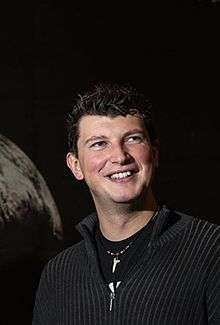Konstantin Batygin

Konstantin Batygin (Russian: Константи́н Юрьевич Батыгин) is a Russian-American astronomer and Assistant Professor of Planetary Sciences at Caltech.[1] He is on the 2015 Forbes list of 30 scientists under 30 who are changing the world,[2] and has been named one of the "brilliant 10" people of 2016 by Popular Science magazine.[3]
Early life
Konstantin Batygin was born in Moscow, Soviet Union.[4] His father, Yuri Konstantinovich Batygin, worked as an accelerator physicist in the Moscow Engineering Physics Institute until 1994, when he moved along with his wife Galina[5] and their family to Wakō, Japan, and began working at the particle accelerator facility in RIKEN.[4] There, Konstantin graduated from a public Japanese elementary school, later on attending a Russian embassy-based school and studying the martial art Gōjū-ryū.[4]
In late 1999, at age 13,[2] Konstantin Batygin moved to Morgan Hill, California[6] along with his family. Upon graduating from Santa Teresa Highschool[7], he chose to attend the University of California, Santa Cruz for the beach and the chance to keep playing in his rock band, The Seventh Season.[4][8] During his sophomore year as an undergraduate at the university, he met Gregory P. Laughlin at a departmental party, and afterwards they began working together on the Solar System’s long-term dynamical evolution.[4] In June 2008, he graduated from UCSC with a bachelor's degree in astrophysics,[6] and won the Loren Steck Award for his thesis, "The Dynamical Stability of the Solar System".[5] Batygin subsequently went on to pursue graduate studies at Caltech, obtaining a Ph.D. in Planetary Science in 2012.
Career
Konstantin Batygin's research is primarily aimed at understanding the formation and evolution of planetary systems. In 2010, Konstantin Batygin and David J. Stevenson published a calculation,[9] which showed that hot Jupiters can become inflated as a consequence of Ohmic dissipation of electrical currents induced through an interaction between ionized atmospheric winds and the planetary magnetic field. In 2012, Batygin demonstrated that misalignments between stellar spin-axes and planetary orbits can arise from gravitational perturbations exerted onto protoplanetary disks by primordial companions stars.[10][11] In 2015, Batygin and Laughlin hypothesized that the Solar System once possessed a population of short-period planets that were destroyed by Jupiter's migration through the solar nebula.[12] In January 2016, Konstantin Batygin and Michael E. Brown proposed the existence of a ninth planet in the Solar System.[8] In 2018, Batygin showed that the evolution of astrophysical disks can be modeled with the Schrödinger equation - a cornerstone of quantum mechanics[13], a concept that strongly resembles some aspects of the theory known as Scale Relativity.
References
- ↑ Konstantin Batygin. "Home". Gps.caltech.edu. Retrieved 21 January 2016.
- 1 2 Sarah Hedgecock (January 5, 2015). "30 Under 30: Young Scientists Who Are Changing The World". Forbes. Retrieved January 21, 2016.
- ↑ "The Man Whose Models Revealed A Possible Ninth Planet In Our Solar System". Retrieved 2016-09-07.
- 1 2 3 4 5 Konstantin Batygin. "About Me". Gps.caltech.edu. Retrieved January 22, 2016.
- 1 2 "Undergraduate awards ceremony caps annual Student Achievement Week". University of California Santa Cruz. June 9, 2008. Retrieved 28 January 2016.
- 1 2 Tim Stephens (June 9, 2008). "Study by UCSC undergrad shows a solar system gone wild". University of California Santa Cruz. Retrieved 28 January 2016.
- ↑ "Konstantin Batygin". www.facebook.com. Retrieved 2018-09-27.
- 1 2 Eric Hand (20 January 2016). "Astronomers say a Neptune-sized planet lurks beyond Pluto". Science. Retrieved 21 January 2016.
- ↑ Batygin, Konstantin; Stevenson, David J. (2010-01-01). "Inflating Hot Jupiters with Ohmic Dissipation". The Astrophysical Journal Letters. 714 (2): L238. arXiv:1002.3650. Bibcode:2010ApJ...714L.238B. doi:10.1088/2041-8205/714/2/L238. ISSN 2041-8205.
- ↑ "Did a lost star knock the Earth off its orbit? New theory to explain why our planet circles the sun at an angle to the solar equator". Retrieved 2016-08-02.
- ↑ Batygin, Konstantin. "A primordial origin for misalignments between stellar spin axes and planetary orbits". Nature. 491 (7424): 418–420. arXiv:1304.5166. Bibcode:2012Natur.491..418B. doi:10.1038/nature11560. PMID 23151584.
- ↑ "Jupiter might have wrecked the first version of our solar system". Washington Post. Retrieved 2016-08-02.
- ↑ Mandelbaum, Ryan F. "Fundamental Equation of Quantum Physics Also Describes Rings and Disks in Space". Gizmodo. Retrieved 2018-03-05.